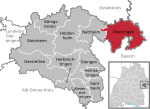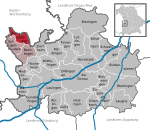The Battle of Neresheim (11 August 1796) was fought by the Republican French army under Jean Victor Marie Moreau against the army of the Habsburg monarchy of Archduke Charles, Duke of Teschen. Pursued by Moreau's Army of Rhin-et-Moselle, Charles launched an attack against the French. While the Austrian left wing saw some success, the battle degenerated into a stalemate and the archduke withdrew further into the Electorate of Bavaria. Neresheim is located in the state of Baden-Württemberg in Germany a distance of 57 kilometres (35 mi) northeast of Ulm. The action took place during the War of the First Coalition, part of a larger conflict called the French Revolutionary Wars.
In the Rhine Campaign of 1796, two French armies successfully breached the Rhine River to invade Germany, Moreau's army in the south and Jean-Baptiste Jourdan's Army of Sambre-et-Meuse in the north. The French armies operated independently while Charles commanded both Maximilian Anton Karl, Count Baillet de Latour's Army of the Upper Rhine in the south and Wilhelm von Wartensleben's Army of the Lower Rhine in the north. Charles hoped to concentrate superior strength against one of the two French armies. To keep his enemies separated, the archduke wished to lure Moreau south of the Danube River by crossing to the south bank. To allow his columns to cross the river safely, Charles attacked the French, hoping to push them back. Though he failed to defeat the French, the battle gave the archduke enough space to get his troops over the Danube without interference. Though he had a chance to join his army to Jourdan's in the north, Moreau soon crossed to the south bank in pursuit.












